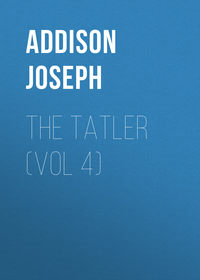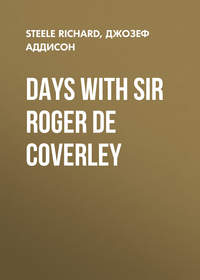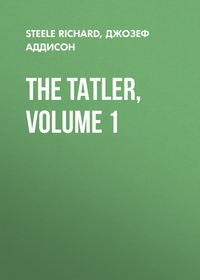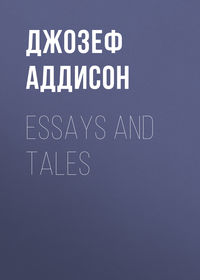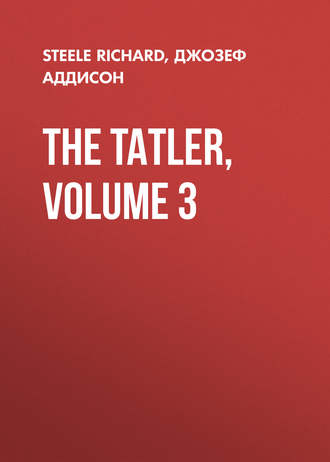 полная версия
полная версияThe Tatler, Volume 3
32
"De Amicitia," vii.
33
L. A. Senecæ Opera, Lips., 1741, ii. 520.
34
See Nos. 120, 123.
35
See No. 120.
36
The first State lottery of 1710; see No. 87. Various passages in the "Wentworth Papers" (pages 126, 127, 129, 130, 148, 165) throw light upon this subject. Thus, "I hear the Million Lottery is drawing and thear is a prise of 400l. a year drawn, and Col. St. Pear has gott 5 (sic) a year; it will be hard fate if you mis a pryse that put so much in. I long tel its all drawn; they say it will be six weeks drawing" (Aug. 1, 1710). "It will be a long time first if ever, except I win ye thoussand p^d a year, for mony now adays is the raening passion" (July (?) 1710). "Some very ordenary creeture has gott 400l. a year" (Aug. 4, 1710). "Thear is a lady gave her footman in the last before this, mony for a lot, and he got five hundred a year, and she would have half, and they had a law suit, but the lawyers gave it all to him" (Aug. 7, 1710). "Betty has lost all her hopse of the Lottery, als drawn now" (Oct. 6, 1710). "You know your grandfather's Butler (?), they say he put ten thousand pd in the lottry and lost it all, and is really worth forty thousand pd" (Dec. 15, 1710). Swift refers to the drawing in September: "To-day Mr. Addison, Colonel Freind and I went to see the million lottery drawn at Guildhall. The jackanapes of blue-coat boys gave themselves such airs in pulling out the tickets, and shewed white hands open to the company to let us see there was no cheat" ("Journal to Stella," Sept. 15, 1710). See also Nos. 170, 203, and the Spectator, No..
37
See No. 128.
38
"There were 150,000 tickets at £10 each, making £1,500,000, the principal of which was to be sunk, and 9 per cent. to be allowed on it for thirty-two years. Three thousand seven hundred and fifty tickets were prizes from £1000 to £5 per annum; the rest were blanks—a proportion of thirty-nine to one prize, but, as a consolation, each blank was entitled to fourteen shillings per annum during the thirty-two years" (Ashton's "Social Life in the Reign of Queen Anne," i. 114).
39
The possessor of a fortune of £100,000.
40
L. A. Senecæ Opera, Epist. viii. sect. 3 (Lips., Tauchn., 1832, iii. 14).
41
Cf. Swift's "City Shower," in No. 238: "She, singing, still whirls on her mop."
42
Cf. No. 128.
43
This penny lottery seems to have been a private undertaking, not warranted by Act of Parliament, or intended to raise any part of the public revenue. In the year 1698, a "Penny Lottery" was drawn at the theatre in Dorset Garden, as appears from the title of the following pamphlet, apparently alluded to here: "The Wheel of Fortune: or, Nothing for a Penny. Being remarks on the drawing of the Penny Lottery at the Theatre Royal in Dorset Garden. With the characters of some of the honourable trustees, and all due acknowledgment to his Honour the Undertaker. Written by a person who was cursed mad that he had not the Thousand Pounds Lot" (Nichols).
44
The following was the advertisement: "A plain gold watch, made by Tompion, with a gold hook and chain, a cornelian seal set in gold, and a cupid sifting hearts, was dropt from a lady's side in or near Great Marlborough Street on Thursday night last. Whoever took it up, if they will bring it to Mr. Plaistow's, at the Hand and Star between the two Temple Gates, in Fleet Street, shall receive five guineas reward.—Signed John Hammond."
45
See No. 123.
46
Cicero, Tusc. Disp. iii. 4, &c.; Orat. pro Dom. 33, &c.
47
Mr. Dobson quotes from Burton's "Anatomie of Melancholy" (1628), p. 18: "I will evince it, that most men are mad, that they had as much need to go a pilgrimage to the Anticyræ (as in Strabo's time they did) as in our dayes they run to Compostella, our Lady of Sichim, or Lauretta, to seeke for helpe; that it is likely to be as prosperous a voyage as that of Guiana, and there is much more need of Hellebor than of Tobacco."
48
Hellebore was much used by the ancients as a cure for madness and melancholy.
49
The best Hungary water (a popular scent) was made of spirits of wine, rosemary in bloom, lavender flowers, and oil of rosemary.
50
Dealing in ideas instead of realities.
51
Bedlam; see No. .
52
The statues by C. G. Cibber.
53
See No. 51.
54
Bayle, in his life of this devotee, 1697, says that Antoinette Bourignon was born at Lisle in 1616, so deformed, that it was debated for some days in the family, whether it was not proper to stifle her as a monster. Her deformity diminishing, they laid aside the thought. Although she was of a morose and peevish temper, and embroiled in troubles most part of her life, she seemed to be but forty years of age when she was above sixty; never made use of spectacles, and died at Franeker, in the province of Frise, in 1680. From her childhood to her old age she had an extraordinary turn of mind. She published a multitude of books, filled with singular doctrines, such as might be expected from a person who roundly asserted, on the express declaration, she said, of God Himself, "That the examination of things by reason, was the most accursed of all heresies, formal atheism, a rejection of God, and the substitution of corrupt reason in his place." She pretended to inspiration, and boasted of extraordinary communications with God; but appears to have been exceedingly defective in the essential duties of humility and charity. She was a woman of such ill conditions and odd behaviour, that nobody could live with her; and she seriously maintained, that anger was a real virtue. She contrived to accumulate money, but continued always uncharitable upon principle, alleging the errors of her understanding in defence of the inhumanity of her conduct.
55
"Advertisement.—Proposals for printing the Lucubrations of Isaac Bickerstaff, Esq., by subscriptions, are to be seen, and subscriptions taken by Charles Lillie, a perfumer, at the corner of Beaufort Buildings, in the Strand, and John Morphew, near Stationers Hall." See No. 80, note. The same proposals are advertised at the end of the subsequent papers in the original folio, with the following variation and addition: Proposals for printing, &c. by subscriptions, "in two volumes in octavo, on a large character and fine royal paper," &c. In No. 134, &c., there was this addition: "All persons that desire to subscribe to this work are desired to send their subscriptions before the 25th instant, it being intended to print no more than what shall be subscribed for, and to begin on the 27th in order to have it published before Easter." In No. 139 (Feb. 25-28) was the announcement, "this day put to press." The idea of publishing by Easter was given up after No. 153. The books were not ready for the subscribers until July 10 (see No. 195, Advertisement). The third and fourth volumes of the Tatler were advertised as "ready to be delivered" in No. 227 of the Spectator (Nov. 20, 1711). The copies on royal paper were issued at a guinea a volume, and copies on medium paper at half a guinea. "I am one of your two-guinea subscribers," says the writer of No. 5 of the Examiner (Aug. 31, 1710).
56
"Eunuchus," II. ii. 23. See No. 208.
57
Bedlam.
58
In Shire Lane. See No. 132.
59
"Perhaps the most consummately drawn of all his characters is introduced in the Essay, No. 127.... We have a portrait of that kind which, though produced by a few apparently careless touches, never ceases to charm, and is a study for all succeeding time and painters" (Forster's Essay on Steele). "This character," wrote Leigh Hunt, "is one of the finest that ever proceeded from his pen. It shows his contempt of that absurdest of all the passions of mortality—pride. The reader will take notice of the exquisite expression 'insolent benevolence,' and the 'very insignificant fellow, but exceeding gracious'" ("A Book for a Corner," ii. 78-9).
60
Bring down from its state of superiority.
61
Nichols suggests an allusion to Mary Ann, daughter of Baron Spanheim, the Bavarian ambassador. She married the Marquis de Montandre in April 1710, and was a Kit-Cat toast. The reference—if there is any personal reference at all—may equally well be to any one of the beauties of the time.
62
See No. 124.
63
Altered, in error, to "three," in the 1711 edition. In No. 124 "ten months" remains. The drawing was at Michaelmas 1710.
64
There is the following note in No. 130 (orig. folio): "Errata in the last. Insert the following motto, which was overlooked by the printer," &c. "Col. 2, line 16, for Oration read Ovation." Probably this paper, No. 129, was by Addison, not only because of these corrections, but because of the allusions to medals, &c., in the letter from Pasquin. The paper is, however, not included in Addison's Works.
65
"To be seen daily, at the Duke of Marlborough's Head in Fleet Street, a new moving picture, drawn by the best hand, with great variety of curious motions and figures, which form a most agreeable prospect. It has the general approbation of all who see it, and far exceeds the original formerly shown at the same place.—N.B. This picture was never exposed to public view, before the beginning of the present year 1710" (No. 127, Advertisement). "The famous and curious original moving picture, which came from Germany, that was designed for the Elector of Bavaria, is still to be seen at the Duke of Marlborough's Head, in Fleet Street;" &c.—Postman, March 1-3, 1709 [-10].
66
Charles Wager was first made a captain at the battle of La Hogue by Admiral Russell, who recommended him on the most important services. He was sent commodore to the West Indies in 1707, where he attacked the Spanish galleons, May 28, 1708, with three ships, though they were fourteen in number drawn up in line of battle, and defeated them. His services Queen Anne distinguished by sending him a flag as Vice-admiral of the Blue, intended for him before this engagement, and by honouring him at his return with knighthood. His share of prize-money amounted to 100,000l. But the riches he acquired, on this and other occasions, were regarded by him only as instruments of doing good; accordingly he gave fortunes to his relations, that he might see them happy in his lifetime; and to persons in distress, his liberality was such, that whole families were supported, and their estates and fortunes saved, by his generosity. He was promoted to be Rear-admiral of the Red, November 9, 1709; and in that year was returned for Portsmouth to Parliament, where he continued to sit till his death. In April 1726, he was sent up the Baltic as Vice-admiral of the Red, with a large fleet on an important expedition; and performed all that could be expected from the wisdom and skill of an English admiral. He dined with the King of Denmark; had an audience of the King of Sweden; and exchanged many civilities with Prince Menzikoff, then Prime Minister of Russia. He was appointed Comptroller of the Navy in February 1714; a Lord of the Admiralty in March 1717; and, on the death of Lord Torrington in January 1732-3, he was placed at the head of that Board, and appointed president of the corporation for relief of poor sea-officers' widows, and also president of the corporation of the Trinity House. He was appointed one of the Lords Regent in 1741; Vice-admiral of England and Treasurer of the Navy in 1742; and died May 24, 1743, aged 77. A prudent, temperate, wise, and honest man, he was easy of access to all, unaffected in his manners, steady and resolute in his conduct, affable and cheerful in his behaviour, and in time of action or imminent danger was never hurried or discomposed (Nichols).
67
"Epig." i. 20.
68
See No. 130, Advertisement.
69
Nichols suggests that this paper may be by Addison, because in No. 131 Addison has the following note: "For the benefit of my readers, I think myself obliged here to let them know that I always make use of an old-fashioned e, which very little differs from an o. This has been the reason that my printer sometimes mistakes the one for the other; as in my last paper, I find, those for these, beheld for behold, Corvix for Cervix, and the like." The internal evidence supports this view; but the paper is not included in Addison's Works.
70
The Duke of Marlborough.
71
Sidney, Lord Godolphin.
72
Lord Somers. See No. .
73
Lord Chancellor Cowper. See the Dedication to this volume.
74
Edward Russell, Earl of Oxford. See No. .
75
Thomas, Earl of Wharton, the Lord-Lieutenant of Ireland.
76
See Nos. , 51. Estcourt was apprenticed to an apothecary, and is said to have tried that business before going on the stage.
77
Eclog. iv. 29.
78
See No. 138.
79
A fashionable eating-house in Abchurch Lane, kept by one Pontack, who was son of the President of Bordeaux, then owner, as Evelyn tells us, of the excellent vineyards of Pontaq and Haut Brion.
80
Paths.
81
The Trumpet stood about half-way up Shire Lane, between Temple Bar and Carey Street, at the widest and best part of the lane, and remained almost entirely in its original state until demolished to make way for the new Law Courts. It had the old sign of the Trumpet to the last, as it is figured in Limbard's "Mirror," in a picture where it is placed side by side with a view of the house in Fulwood's Rents where papers for the Spectator were taken in.
82
July 2, 1644.
83
In July 1647 the London apprentices presented a petition, and forced their way into the House of Commons.
84
This retort, in almost identical words, occurs in Swift's "Genteel Conversation" (1739), and in Defoe's "Life of Duncan Campbell" (1720).
85
Jack Ogle, said to have been descended from a decent family in Devonshire, was a man of some genius and great extravagance, but rather artful than witty. Ogle had an only sister, more beautiful, it is said, than was necessary to arrive, as she did, at the honour of being a mistress to the Duke of York. This sister Ogle laid under very frequent contributions to supply his wants and support his extravagance. It is said that, by the interest of her royal keeper, Ogle was placed, as a private gentleman, in the first troop of foot guards, at that time under the command of the Duke of Monmouth. To this era of Ogle's life the story of the red petticoat refers. He had pawned his trooper's cloak, and to save appearances at a review, had borrowed his landlady's red petticoat, which he carried rolled up en croupe behind him. The Duke of Monmouth "smoked" it, and willing to enjoy the confusion of a detection, gave order to "cloak all," with which Ogle, after some hesitation, was obliged to comply; although he could not cloak, he said he would petticoat with the best of them. Such as are curious to know more of the history, the duels, and odd pranks of this mad fellow, may consult the account of them in the "Memoirs of Gamesters," 1714, 12mo, p. 183 (Nichols).
86
"When pulpit drum ecclesiasticWas beat with fist instead of a stick."—"Hudibras," Part I. c. i. line 10.87
Cf. No. 130, Advertisements. The dangers of the streets at the beginning of the eighteenth century are described in Gay's "Trivia," iii. 335 seq.
88
"Iliad," i. 249.
89
Milton says of Belial ("Paradise Lost," ii. 112):
"But all was false and hollow, though his tongueDropped manna, and could make the worse appearThe better cause."90
"Iliad," iii. 3.
91
"Odyssey," xi. 563.
92
"Æneid," vi. 46.
93
Sichæus.
94
Jaffier. See Otway's "Venice Preserved," act v. sc. 3.
95
In the preface to his "Institutes of the Laws of England; or, a Commentary upon Littleton," Coke says, "Certain it is, that there is never a period, nor (for the most part) a word, nor an &c., but affordeth excellent matter of learning."
96
See No. 112.
97
See the date of this number.
98
Sticks used in the game of tip-cat and trap-ball.
99
Cf. the Spectator, No. , where Addison refers to Sir Paul Rycaut's work on the Ottoman Empire.
100
Disingenuousness.
101
See Nos. , .
102
"Cock-fighting is diverting enough, the anger and eagerness of these little creatures, and the triumphant crowing of a cock when he strutts haughtily on the body of his enemy, has something in't singular and pleasant. What renders these shows less agreeable is the great number of wagerers, who appear as angry as the cocks themselves, and make such a noise that one would believe every minute they were going to fight; but combats among the men are another kind of diversion, where the spectators are more peaceable" ("Letters describing the Character and Customs of the English and French Nations; by Mr. Muralt, a Gentleman of Switzerland. 2nd ed.; translated from the French." London, 1726, p. 41). In Hogarth's picture of a cock-fight a Frenchman is depicted turning away in disgust (see Lecky's "History of England in the Eighteenth Century," 1878, i. 552). "There will be a cock-match fought at Leeds in Yorkshire, the 19th of March next; and another at Wakefield the 23rd of April next. At each meeting 40 Cocks on each side will be shewn. These are fought betwixt the people of the West and North Riding of Yorkshire; And every Battel 5l. each side, and 50l. the odd Battel, and four Shake Bags for 10l. each Cock" (London Gazette, March 8-12, 1687). A cock-match between Surrey and Sussex was to commence on May 4, 1703, "and will continue the whole week" (London Gazette, April 12-15, 1703) "The Royal Pastime of Cock-fighting, or, the Art of Breeding, Feeding, Fighting and Curing Cocks of the Game. Published purely for the good and benefit of all such as take Delight in that Royal and Warlike Sport. To which is prefixed, a Short Treatise, wherein Cocking is proved not only ancient and honourable, but also useful and profitable. By R. H., a Lover of the Sport, and a friend to such as delight in Military Discipline" (Post Boy, Jan. 15-18, 1708-9).
103
Addison, also referring to Rapin, writes to the same effect in the Spectator, No. 44. Rapin said, in his "Reflections on Aristotle's Treatise of Poetry," translated in 1694: "The English, our neighbours, love blood in their sports, by the quality of their temperament.... The English have more of genius for tragedy than other people, as well by the spirit of their nation, which delights in cruelty, as also by the character of their language, which is proper for great expressions." There is an "Address to the Cock-killers" in Lillie's "Letters sent to the Tatler and Spectator," i. 25-29.
104
Samuel Sandford seems to have left the stage about 1700. He had a low and crooked person, and Cibber describes him as "an excellent actor in disagreeable parts." Charles II. called him the best villain in the world. There is a story of a new play being damned because Sandford played the part of an honest statesman, and the pit was therefore disappointed at not seeing the usual Iago-like or Machiavelian character.
105
In speaking of Collins' "Discourse of Free-Thinking" (1713) in the Guardian (No. 9), Steele says: "I cannot see any possible interpretation to give this work, but a design to subvert and ridicule the authority of scripture. The peace and tranquillity of the nation, and regards even above those, are so much concerned in this matter, that it is difficult to express sufficient sorrow for the offender, or indignation against him."
106
See the motto at the head of this paper.
107
"Tusc. Disp." i. 17. Cicero calls those who differ from Plato and Socrates "plebii omnes philosophi" (ib. i. 23).
108
Nichols suggests that this paper may be by Addison, and it is certainly not unlikely that he was the author of the "History of Tom Varnish."
109
A portion of Henry VIII.'s palace at Whitehall. When Whitehall was burned down in 1697, the Cockpit escaped, and was used as a Court for the Committee of the Privy Council.
110
"Henry the Fifth," Prologue.
111
"Julius Cæsar," act iii. sc. i.
112
"Æneid," i. 294.
113
See Nos. 115, 142.
114
A description of the custom of drawing valentines, and of the hope and fear shown on the faces of the drawers, who in their earnestness gave to a scrap of paper the same effect as the person represented, is to be found in Lillie's "Letters sent to the Tatler and Spectator" (1725), i. 30. See No. 141.
115
See No. 99.
116
"Republic," ii. 359.
117
"De Officiis," iii. 9.
118
"Bell. Cat." ad fin.
119
"The Paul's scholar's copy-book, containing the round and round-text hands, with alphabets at large of the Greek and Hebrew, and joining-pieces of each. Embellished with proper ornaments of command of hand. By John Rayner, at the Hand and Pen, in St. Paul's Churchyard, London. Published for the use of schools. Sold by the author, and Jonathan Robinson, at the Golden Lion, in St. Paul's Churchyard. Price 1s." (No. 135, Advertisement). Rayner's book was dedicated to the Master and Wardens of the Mercers' Company, and was reissued in 1716 (W. Massey's "Origin and Progress of Letters," 1763, part ii. p. 120).
120
See No. 141.
121
Bedlam.
122
See No. 131.
123
See No. 125.
124
See No. 138.
125
"Under a Lady's Picture" (Waller's Poems: "Epigrams, Epitaphs," &c.).
126
See No. .



